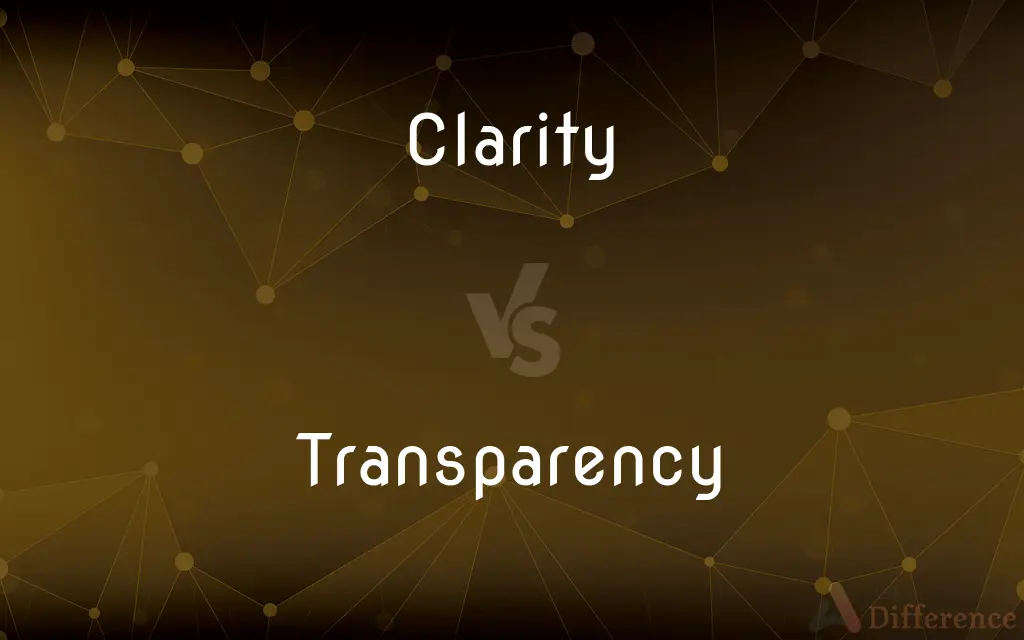Clarity vs. Transparency — What's the Difference?
By Fiza Rafique & Urooj Arif — Updated on April 9, 2024
Clarity refers to the quality of being easily understood, while transparency is about openness and the disclosure of information.

Difference Between Clarity and Transparency
Table of Contents
ADVERTISEMENT
Key Differences
Clarity is the attribute of being easily understandable or free from ambiguity, focusing on how information is presented. It ensures that the message is conveyed in a straightforward manner, making it accessible to the audience. On the other hand, transparency deals with the willingness to share information, practices, and processes openly and honestly. It is not just about the clarity of the information but also about making all relevant details available and visible to those who seek them.
While clarity enhances comprehension and reduces misunderstandings by simplifying complex information, transparency builds trust and accountability by revealing the full context or background of decisions, actions, or data. Transparency can exist without clarity if information is available but not easily understood, whereas clarity without transparency might mean that the information is clear but not all information is disclosed.
Clarity aims at the precision of communication, focusing on the "how" of message delivery. Effective clarity eliminates confusion by using straightforward language and explaining concepts in simple terms. Transparency, however, emphasizes the "what" and "why" behind information, encouraging a culture of openness and promoting informed decision-making among stakeholders.
In settings where trust and ethical standards are paramount, such as in governance or corporate practices, transparency is crucial for maintaining public confidence. Clarity, while equally important, serves as a tool to ensure that the transparently provided information is comprehensible to its audience.
Both clarity and transparency are essential in fostering an environment of understanding and trust. Clarity ensures that messages are interpreted correctly, while transparency allows individuals to see the full picture, including the motives and processes behind actions or decisions.
ADVERTISEMENT
Comparison Chart
Focus
Making information understandable
Making information available
Key Quality
Comprehensibility, lack of ambiguity
Openness, honesty
Importance in
Communication
Governance, business practices
Relationship
Can have clarity without full transparency
Can be transparent without being completely clear
Outcome
Reduces misunderstandings
Builds trust and accountability
Compare with Definitions
Clarity
Crucial for effective understanding and communication.
The teacher emphasized clarity in students' essays to improve their writing skills.
Transparency
Fosters accountability and trust among stakeholders.
Transparency in government spending is essential for public trust.
Clarity
Making ideas accessible through simplicity.
His clarity of expression made complex topics easy for anyone to grasp.
Transparency
Associated with ethical business practices.
Transparency is a key tenet of their corporate social responsibility policy.
Clarity
Ensures messages are interpreted correctly.
The report's clarity helped stakeholders quickly grasp the business strategy.
Transparency
Willingness to share detailed information.
Their transparency in financial dealings reassured investors.
Clarity
Centers on the comprehensibility of the message.
She was admired for the clarity with which she could explain scientific concepts.
Transparency
Making actions and decisions visible to outsiders.
The NGO's transparency about fund usage attracted more donors.
Clarity
The quality of being clear and easy to understand.
The clarity of her instructions prevented any confusion during the project.
Transparency
The practice of being open and honest in disclosing information.
The company's transparency about its manufacturing process built customer trust.
Clarity
The quality of being coherent and intelligible
For the sake of clarity, each of these strategies is dealt with separately
Transparency
The condition of being transparent
The transparency of ice
Clarity
The quality of transparency or purity
The crystal clarity of water
Transparency
A positive transparent photograph printed on transparent plastic or glass, able to be viewed using a slide projector
Colour transparencies of the Grand Canyon
Clarity
Clearness of appearance
The clarity of the mountain air.
Transparency
Also trans·par·ence (-pârəns, -păr-) The quality or state of being transparent.
Clarity
Clearness of thought or style; lucidity
Writes with clarity and perception.
Transparency
A transparent object, especially a photographic slide that is viewed by light shining through it from behind or by projection.
Clarity
The state or measure of being clear, either in appearance, thought or style; lucidity.
She dreamed with great clarity.
The brilliant clarity of his argument could not be faulted.
Transparency
(uncountable) The quality of being transparent; transparence.
Clarity
The ability to be easily understood.
Lack of clarity on the part of the teacher will cause confusion among the students.
Transparency
(uncountable) Openness; accessibility to scrutiny.
Clarity
Clearness; brightness; splendor.
Floods, in whose more than crystal clarity,Innumerable virgin graces row.
Transparency
A transparent artwork, viewable by shining light through it.
Clarity
Free from obscurity and easy to understand; the comprehensibility of clear expression
Transparency
A translucent film-like material with an image imprinted on it, viewable by shining light through it.
Clarity
The quality of clear water;
When she awoke the clarity was back in her eyes
Transparency
(countable) A transparent object.
Transparency
(signal processing) Sufficient accuracy to make the compressed result perceptually indistinguishable from the uncompressed input.
Transparency
The quality or condition of being transparent; transparence.
Transparency
That which is transparent; especially, a picture painted on thin cloth or glass, or impressed on porcelain, or the like, to be viewed by natural or artificial light, which shines through it.
Transparency
Permitting the free passage of electromagnetic radiation
Transparency
The quality of being clear and transparent
Transparency
Picture consisting of a positive photograph or drawing on a transparent base; viewed with a projector
Common Curiosities
Can there be transparency without clarity?
Yes, information can be available (transparent) but not easily understood (lacking clarity).
How does clarity affect communication?
Clarity ensures that messages are easily understood, reducing misunderstandings and confusion.
What is clarity?
Clarity is the quality of being clear, understandable, and free from ambiguity in communication.
Why is transparency important in businesses?
Transparency builds trust with stakeholders, demonstrating openness and ethical practices.
How does clarity benefit learning?
Clarity in teaching methods and materials enhances students' comprehension and engagement.
Can clarity be subjective?
Yes, what is clear to one person may not be to another, underscoring the importance of audience understanding.
What role does transparency play in governance?
Transparency is crucial for accountability, allowing citizens to be informed about government actions and decisions.
How can organizations improve clarity?
Organizations can improve clarity by simplifying complex information and using clear, straightforward language.
What does transparency mean?
Transparency refers to the practice of being open and honest, making all relevant information accessible and visible.
What are the benefits of transparency in a workplace?
Transparency in the workplace fosters a culture of trust, encourages open communication, and enhances team cohesion.
How do clarity and transparency relate to ethics?
Both are grounded in ethical communication, promoting honesty, understanding, and trust.
How does transparency impact stakeholder relationships?
Transparency strengthens relationships by demonstrating a commitment to openness and accountability.
Is it possible to have too much transparency?
Excessive transparency can lead to information overload or privacy concerns, highlighting the need for balance.
What measures can enhance transparency in organizations?
Enhancing transparency can involve regular updates, open-door policies, and accessible reporting mechanisms.
What challenges can arise from a lack of clarity?
A lack of clarity can lead to misunderstandings, errors, and decreased efficiency in communication.
Share Your Discovery

Previous Comparison
Putrid vs. Rotten
Next Comparison
Backwoods vs. BackwaterAuthor Spotlight
Written by
Fiza RafiqueFiza Rafique is a skilled content writer at AskDifference.com, where she meticulously refines and enhances written pieces. Drawing from her vast editorial expertise, Fiza ensures clarity, accuracy, and precision in every article. Passionate about language, she continually seeks to elevate the quality of content for readers worldwide.
Co-written by
Urooj ArifUrooj is a skilled content writer at Ask Difference, known for her exceptional ability to simplify complex topics into engaging and informative content. With a passion for research and a flair for clear, concise writing, she consistently delivers articles that resonate with our diverse audience.














































